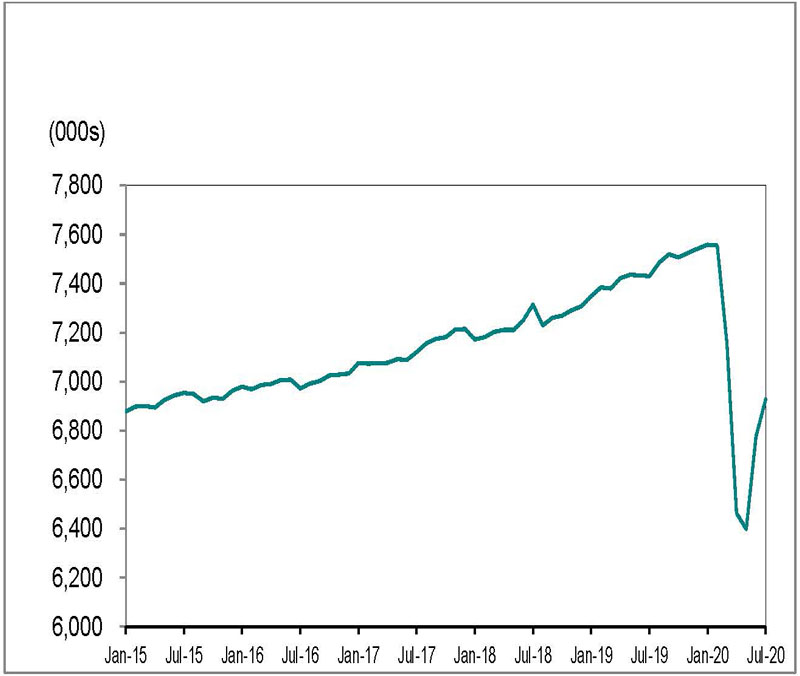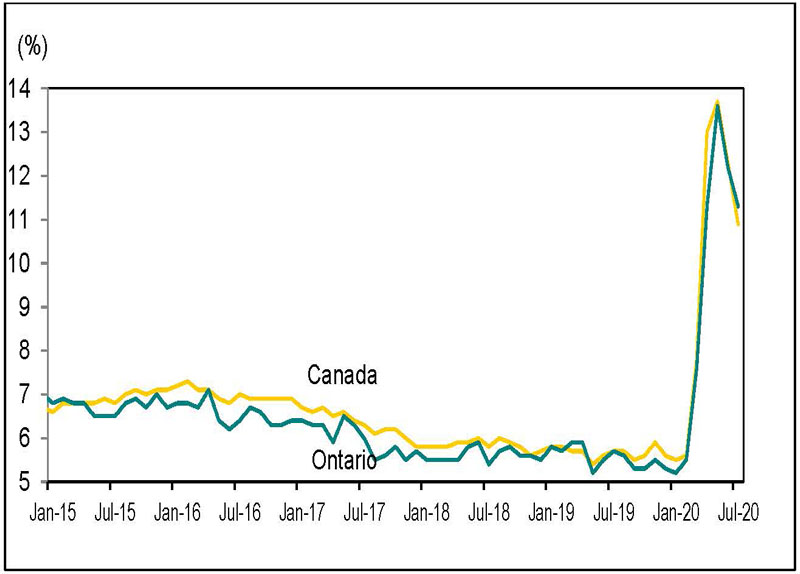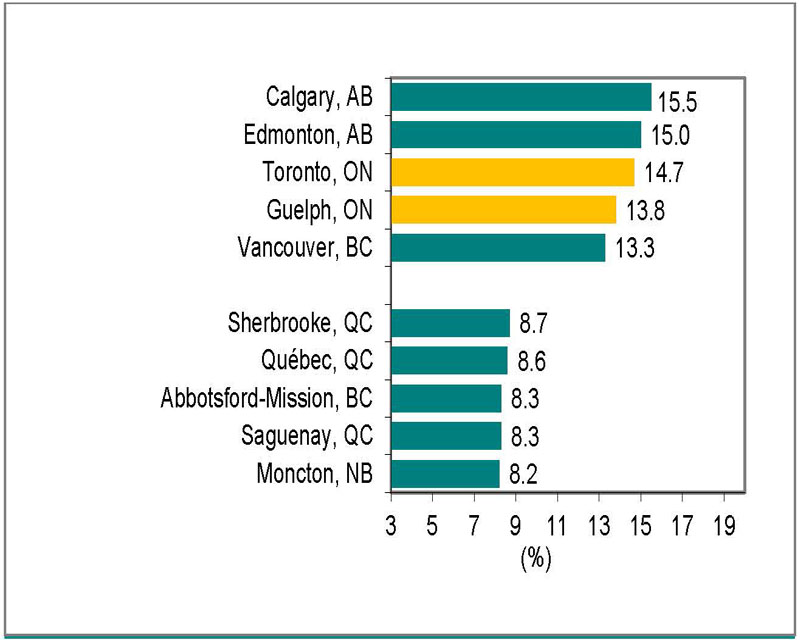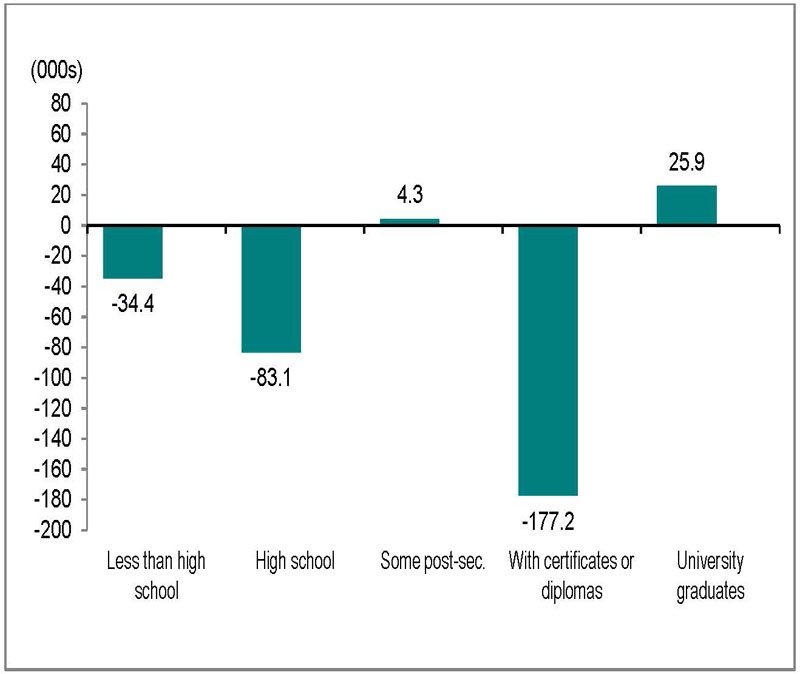Labour market report, July 2020
Employment in Ontario increased by 150,700 jobs in July. Get the details in this report.
Quick facts
In July 2020:
- There were 12.3 million people in Ontario aged 15 years or older
- 7.8 million (63%) were in the labour force, including those who had worked, were unemployed or did not work at their job because of ongoing business closures. The labour force increased by 1.2% (93,900) compared to June
- 6.9 million (56%) were employed, up 2.2% (150,700 jobs) from June
- Ontario’s unemployment rate decreased to 11.3% in July from 12.2% in June and 886,600 people were unemployed, down 6.0% (56,800) from June
Important note:
This report is based on the Labour Force Survey (LFS), a household survey carried out by Statistics Canada. July’s LFS results cover the reference week of July 12 to 18.
Stage 3 of the Ontario government’s plan for reopening the economy came into effect on July 17 on a regional basis, with Toronto and Peel moving to Stage 3 after the LFS reference week and Windsor-Essex remaining in Stage 2. (See Stage 3 openings).
Ontario’s mandatory closure of non-essential businesses and other measures aimed at addressing the impact of COVID-19 took effect on March 24.
Employment increased in July
Employment increased by 150,700 (2.2%) in July, the second consecutive monthly increase since the COVID-19 economic downturn began. In June, Ontario gained 377,900 jobs.
Over the February-May period, Ontario employment declined by almost 1.2 million, the largest three-month employment decline on record. With July’s increase, 45.7% of the 1.2 million jobs lost in Ontario since the COVID-19 economic downturn began have been recovered.
Most sectors recorded job gains in July. Wholesale and retail trade (57,300) led employment gains in July, followed by health care and social assistance (28,800), other services, except public administration (23,500) and professional, scientific and technical services (17,700).
Educational services (−7,200), business, building and other services (−1,700) and information, culture and recreation (−1,500) led employment losses.
Over half (57.0%) of the job losses over the February-May period were concentrated in four sectors – wholesale and retail trade, accommodation and food services, manufacturing, and health care and social assistance. These sectors account for two-thirds (66.2%) of the jobs gained in June and July.
The total number of hours worked (main job) in Ontario in July decreased by about 1.0% compared to June and are still down by 11.9% compared to February (data are not seasonally adjusted).
Chart 1 shows employment in Ontario from January 2015 to July 2020.

Source: Statistics Canada, Labour Force Survey, Table 14-10-0287-01, (seasonally adjusted data).
Full-time vs. part-time
Part-time jobs (145,100) led the employment increase in July, while full-time jobs increased by 5,600.
Employment increase by age
Youth employment (those aged 15 to 24) increased by 58,600 in July, after increasing by 78,700 jobs in June. Youth were disproportionally impacted by job losses during the February-May downturn period.
Employment for people aged 25 to 54 increased by 60,600 in July, compared to June. Employment for those aged 55 and older increased by 31,400 jobs.
Employment in Canada rose by 418,500 (2.4%) in July. Employment in Canada was still 1,343,500 below its February 2020 level and now totals 17,845,900.
Unemployment rate decreased to 11.3%
Chart 2 shows unemployment rates, Ontario and Canada, January 2015 to July 2020.

Source: Statistics Canada, Labour Force Survey, Table 14-10-0287-01, (seasonally adjusted data).
Ontario’s unemployment rate in July was 11.3%, down from 12.2% in June. The rate has more than doubled since February.
Unemployment rate by age
For individuals aged 15 to 24, the unemployment rate declined to 28.4% from the record high of 30.0% that was recorded in May and June.
The unemployment rate for individuals aged 25 to 54 decreased to 8.8% in July from 9.8% in June and to 7.8% from 8.3% for those aged 55 and older.
Lowest and highest unemployment rates
Chart 3 shows Census Metropolitan Areas (CMAs) with highest and lowest unemployment rates in Canada, July 2020.

Source: Statistics Canada, Labour Force Survey, Table 14-10-0294-01, (seasonally adjusted data three-month moving average to reduce volatility caused by small sample size).
Toronto recorded the highest unemployment rate in Ontario in July (14.7%), while Calgary, Alberta had the highest unemployment rate in Canada, at 15.5%.
Ottawa-Gatineau, Ontario part, recorded the lowest unemployment rate in Ontario in July (9.2%), while Moncton, New Brunswick recorded the lowest unemployment rate in Canada (8.2%).
Year-over-year comparisons
Employment increase and decrease by education level
Over the first seven months of 2020, employment in Ontario declined by 264,500 net jobs for adults 25 years and older compared to the first seven months of 2019.
Chart 4 shows Ontario employment change by highest level of education attained, aged 25 and older, July 2019 year-to-date to July 2020 year-to-date.

Source: Statistics Canada, Labour Force Survey, Table 14-10-0019-01, unadjusted data
Individuals with a postsecondary certificate or diploma and those with high school education led job losses with 177,200 and 83,100, respectively.
People with less than high school education recorded job losses of 34,400.
Adults with a university degree recorded employment gains of 25,900 net new jobs, while those with some postsecondary education gained 4,300 job.
Unemployment rate by education level
The unemployment rate for adults aged 25 and older with postsecondary education credentials was 7.1% in the first seven months of 2020, up from 4.1% a year earlier. The unemployment rate for adults without postsecondary education credentials was 9.8%, up from 6.2% compared to a year ago.
Employment increase and decrease by occupation
Chart 5 shows Ontario employment change by occupation, July 2019 year-to-date to July 2020 year-to-date.

Source: Statistics Canada, Labour Force Survey, Table 14-10-0297-01, unadjusted data.
Seven of the ten major occupational groups in Ontario had employment losses in the first seven months of 2020 compared to a year ago
Learn more about the National Occupational Classification (NOC) system.
These occupations lost the most jobs:
- sales and service (229,200)
- trades, transport and equipment operators (77,400)
- art, culture, recreation and sport (50,900)
These occupations gained jobs:
- natural and applied sciences and related (27,300)
- health (1,500)
- natural resources, agriculture and related production (800)
Download data
Source: Statistics Canada, Labour Force Survey
July 2020 Labour Market Report:
- CSV, Chart 1, employment in Ontario from January 2015 to July 2020, 1 Kb
- CSV, Chart 2, unemployment rates, Ontario and Canada, January 2015 to July 2020, 2 Kb
- CSV, Chart 3, Census Metropolitan Areas (CMAs) highest and lowest unemployment rates, 2 Kb
- CSV, Chart 4, Ontario employment change by highest level of education, aged 25 and older, 99 Kb
- CSV, Chart 5, Ontario employment change by occupation, 12 Kb